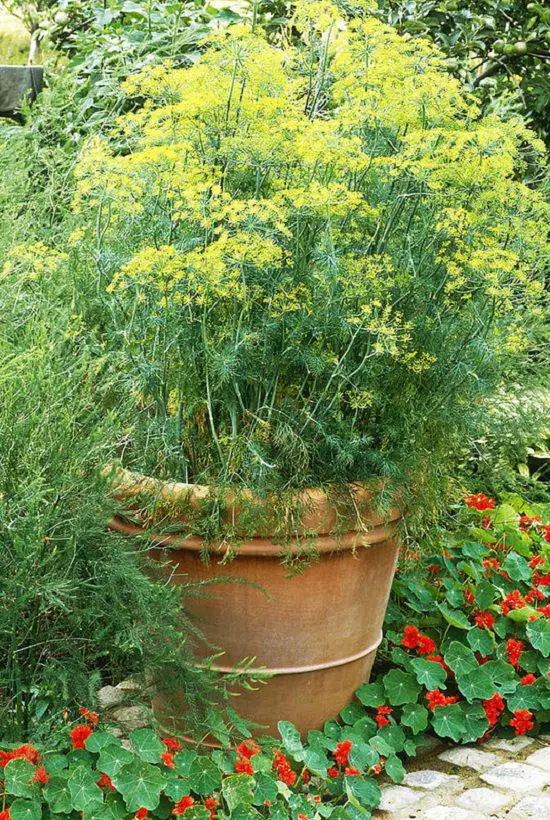Fennel can be quickly grown in pots in a limited space and do not require a lot of maintenance. Continue reading about Growing Fennel in Container!
Fennel is quite popular for its sweet, aromatic dill-like leaves, seeds, and bulbs. This flavorful herb can be paired with a variety of dishes and herbal teas, making it one of the most used culinary herbs! If you too want to enjoy it fresh, then keep reading this article on Growing Fennel in Container!
Botanical Name: Foeniculum vulgare
USDA Zones: 5-10
Check out our article on growing sage in containers here!
Types of Fennel

There are two types of fennel to grow in containers: Florence fennel, which is grown for bulbs and herb fennel, which is grown for leaves and seeds and used as a herb.
Herb Fennel Types
- Sweet fennel: It is used in culinary and medicines, and is a standard variety for producing dry leaves for cooking.
- Rubrum: Also known as Smokey fennel, it has aromatic leaves. The seeds are baked into bread, biscuits, and sausages preparations.
- Purpureum: Has a distinctive bronze leaf color. Mainly used as ornamental.
Bulb Fennel Types
- Victoria: Offers excellent resistance to bolting. Leaves are mainly used fresh in salads.
- Cantino: It is also a bolt resistant variety, generally bulbs are used in soups and stews.
- Rhonda: Quick maturing with uniform round bulbs. Mainly used in making stews.
- Mantavo: This one is a slow bolting variety that offers good yield.
Choosing a Container
Fennel plant can grow up to 3-5 feet tall, depending more on the variety. As its roots grow widespread, select a container that’s at least 12-14 inches deep with drainage holes at the bottom to avoid waterlogging.
When to Grow?
Start sowing seeds indoors, 4 weeks before the last expected date of frost in your area. You can also sow them directly in your patio or balcony after all the predictions of frost are passed and the temperature starts to hover around 60 F (15 C).
For consecutive planting, sow seeds every 3-4 weeks. Do your last sowing of fennel seeds in fall, this should be at least 2 months before the first frost date.
For warm climates, USDA zones 9b-11, you can plant fennel year-round in containers, except the peak summer months. However, the best time is fall! You can grow it till winter and spring and in summer as well, if you’re provide shade from afternoon sun and keep the soil evenly moist.
Want to grow turnips in containers? Click here!
How to Grow Fennel in Pots?
While growing fennel in container seeds are the best option. You can get seeds from a garden store or online. Asian grocery stores are also an excellent place to find them. Or, get them from your spice rack!
- Sow seeds directly into the pot. Sprinkle them and cover with a layer of soil. As fennel has a deep root system, it doesn’t transplant well.
- Keep the soil moist and don’t let it go completely dry.
- The seeds will germinate in 8-14 days.
Requirements for Growing Fennel in Pot

Location
Fennel does well in 6-7 hours of sunlight a day. It’s also important to keep the container at a location where it receives plenty of air circulation to avoid diseases. For growing them indoors, a South or West-facing window is the optimum spot.
Soil
For growing fennel in pots, use a well-draining, loamy soil. It is also a great idea to mix 20 percent aged manure or compost into the potting mix to enrich it.
During the mid growth, you can turn your soil by means of trowel to aerate it. But be extra careful to avoid any damage to your fennel plant.
Watering
If you’re growing the plant in a sunny and well-ventilated location, the soil is going to dry out faster. Be sure to keep the soil slightly moist.
While growing the plant indoors, water the plant only when the topsoil is dry to touch. Also, avoid wetting the foliage and always water at the base.
Here’s everything you need to know about growing Swiss Chards in containers!
Fennel Plant Care
Pruning
Like other herbs, pinch back the growing tips when the plant reaches a height of 5-7 inches. This will allow a bushier growth. If you are harvesting the plant regularly, it won’t require pruning.
Fertilizing
Adding 20 percent compost is sufficient for the fennel plant. Later on, you can side-dress the plant two more times with aged manure or compost, during its growth period.
OR
Once the plant is more than 4 weeks old, fertilize using a balanced liquid fertilizer, providing half of the prescribed dose recommended on the product’s label. Feed the plant once every 4-6 weeks.
Blanching
Once the bulbs start to form at the base of the stem, cover them with soil, making an uphill pattern. This will prevent them from turning green, preserving the sweet flavor. Skip it if you’re not growing the bulb fennel!
Pests & Diseases
Pests like armyworms, cutworms, and aphids can kill the plant. They can be handpicked or washed away with a stream of water. You can also use insecticidal soap.
Diseases like leaf spot, powdery and downy mildew can be detrimental for this herb. Avoid wetting the foliage and provide good air circulation to prevent.
Harvesting and Storage
Start harvesting Herb fennel once the plant reaches a height of 8-10 inches. Use a pair of scissors to cut the leaves, when you need. Do ensure that you are not harvesting more than 1/3 growth of the plant at a time.
For harvesting Bulb fennel, wait till the bulb grows to a size of a ball or 2-4 inches in diameter. Using a sharp knife, cut the top leaves and stalks. Now, pull the bulb upwards using your hands and slice it away from the roots. Wash with water and use right away as it tastes best when fresh!
Fennel tastes best when it fresh. But if you want to store, keep the leaflets in an airtight container. You can also refrigerate the picked leaves for some time.
Benefits of Fennel
- It is low in calories and has anti-bacterial properties, which is suitable for heart health.
- Fennel is also rich in polyphenol antioxidants and apigenin that lowers the risk of obesity and neurological diseases.
- Its powerful antioxidants also help in reducing inflammation.
- The plant also helps in lowering hot flashes and sleep disturbances.



